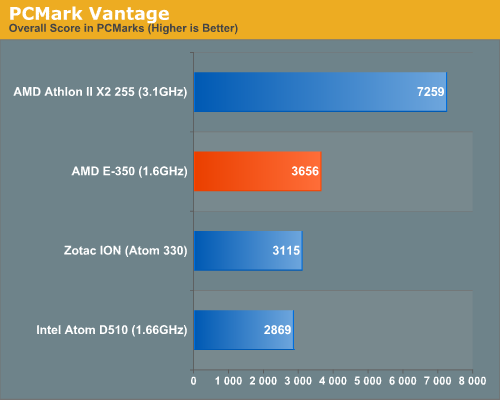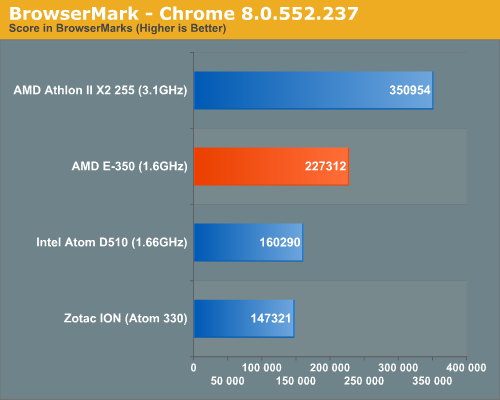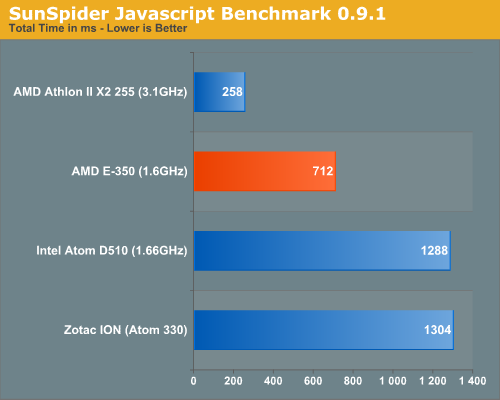The Brazos Review: AMD's E-350 Supplants ION for mini-ITX
by Anand Lal Shimpi on January 27, 2011 6:08 PM ESTGeneral Performance: In Between Atom and Athlon II
Atom may be efficient and fast enough to run a smartphone OS, but it absolutely chugs on Windows 7. The seat of the pants feel of an AMD E-350 is noticeably better. Single threaded performance, as you’ll soon see, is easily twice that of a similarly clocked Atom. Bobcat is still a dual-issue dual-core machine so high IPC or highly threaded workloads will show little difference between it and Atom. Thankfully, for most entry level netbook/nettop workloads Bobcat’s architecture should be sufficient. Before we get to the more CPU intensive tests I wanted to run through some reader requests for performance characterization.
I’ll start out with PCMark Vantage. There’s very little that separates PCMark from SYSMark in terms of how realistic the workload is. Neither suite is particularly representative of what an average user does today. What these suites are good at is being very long, and stressing enough aspects of a platform to give you a general idea of performance. SYSMark tends to focus on the more heavy user/content creation side of things (optimized for no more than 2 cores), while PCMark Vantage is much lighter test.
Looking at SYSMark you’d see no performance difference between the E-350 and Atom. The reason is simple. SYSMark was designed to be a modern day CPU benchmark. Most of the workloads exhibit high IPC and thus Bobcat’s front end acts as a bottleneck.
While SYSMark can be useful in estimating how a processor might handle particular heavy workload, it’s not useful in characterizing the sort of light workloads that you’d see a netbook or nettop user creating. PCMark Vantage is a collection of far simpler tasks. Again not specifically what you’d do today, but lighter nevertheless.
I compared four systems using PCMark Vantage, all with the same memory and I/O configuration. I dusted off an Atom 330 + ION motherboard from Zotac, an Atom D510, the MSI E-350 board and an Athlon II X2 255 on an 890GX motherboard. I picked the Athlon II simply because it’s a very affordable (~$65) modern day dual-core CPU. The Athlon II will help put the E-350’s performance compared to modern day x86 cores in perspective.

The E-350 holds a clear advantage over the Atom D510. The overall suite runs 27% faster on the E-350 than the D510, and even 17% faster than ION (the overall suite includes some GPU tests where ION makes up for Atom). The advantages vary from 10 - 80% in most cases. If you look at tests where the GPU is involved, you have to start counting how many times Brazos is faster than Intel’s current Atom platform.
I have to put the E-350’s dominance in perspective however. An Athlon II X2 255 still delivers nearly 2x the performance of the E-350 in PCMark Vantage. Just as the Atom to E-350 jump is noticeable, so is the jump from an E-350 to an Athlon II.
A performance advantage in PCMark is often difficult to visualize so let’s move on to some more application specific tests. Next up are two web browser benchmarks we typically use in our smartphone reviews: BrowserMark and SunSpider.
BrowserMark is a general purpose browser test. Rather than loading full web pages it tests rendering speed for commonly used components of web pages and presents one gigantic score at the end to tell you which platform is faster. The benchmark is obviously browser dependent so I ran all numbers on the same version of Chrome (8.0.552.237). The test platforms were the same as before:

The E-350 holds a 41% performance advantage over the Atom D510 here. That’s definitely enough to be noticeable in actual usage. In general web browsing is noticeably faster on Brazos than on Atom. The Athlon II is another 50% faster than the E-350. Again, it’s enough to be noticeable.
SunSpider is a collection of javascript benchmarks that we typically run to compare smartphones. It ends up being a good way to compare one aspect of web browsing performance between these entry level platforms.

The Brazos advantage over Atom actually climbs when we look at pure js performance. The E-350 is 80% faster than the Atom D510 here. The Athlon II advantage grows as well. Web browsing can be very CPU bound at times.
Brazos, like Atom, will never compete with its bigger brothers. There’s only so much you can do with a very tiny die. What AMD’s platform does provide however is a stepping stone between Atom and the lower end beefy x86 cores, which is something we’ve needed.
Many of you wanted even more real world testing, focusing on things like application launch time and system boot time. Ask and you shall receive is one of our policies around here (within reason) so I put together a drive image with a ton of applications, games and data. I measured the time it took to boot to the Windows 7 desktop as well as timed individual application launches.
Boot time is a difficult thing to compare between platforms. Everything from BIOS optimizations to the type of video card you have in the system can impact boot time. In this case, the E-350 system managed to boot 13% faster than the Atom system.
Individual applications, specifically light weight apps (e.g. Google Chrome, Media Player Classic), launch relatively quickly on both Atom and Brazos. This is largely due to the fact that I’m testing with an SSD. Regardless there’s still no appreciable difference in launch time between the platforms when the drive bottleneck is removed (the difference doesn’t grow as you add bottlenecks in). Where we see the E-350 really shine is in the larger, more complex applications and games.
| Application Launch Time Comparison | |||||||||||
| Platform | Boot Time (POST to Desktop) | Adobe Reader 9 | IE8 | Chrome | MPC-HC | Cinebench 11.5 | Sonar 8 | CoD: Black Ops | Starcraft II | ||
| AMD E-350 (1.6GHz) | 61.5s | 2.2s | 1.4s | 1.4s | 1.2s | 5.5s | 8.8s | 15.0s | 21.9s | ||
| Intel Atom D510 (1.66GHz) | 70.3s | 1.5s | 1.4s | 1.4s | 1.2s | 3.9s | 10.3s | Fail | 39.8s | ||
| AMD Athlon II X2 255 (3.1GHz) | 53.8s | 1.0s | 0.8s | 0.7s | 0.7s | 2.5s | 4.5s | 5.3s | 9.9s | ||
Sonar 8 launched 17% faster on the E-350 vs. Atom, while Starcraft II launched in almost half the time of the Atom D510 (although I suspect part of the advantage there is GPU related). Not all application launches were faster on the E-350. Occasionally applications would launch faster on the D510, but that seemed to be the exception rather than the rule. Overall system performance is naturally faster on Brazos compared to Atom.
Bring the Athlon II into the picture and things look different. You can cut most of Brazos’ launch times in at least half to get an idea of the Athlon II’s performance.










176 Comments
View All Comments
Matt310 - Friday, January 28, 2011 - link
At home in my desktop machine I have a 4-lane PCI-x hardware RAID card with four 1.5TB drives configured in RAID 5 for speed hand fault tolerance. For a while now I've been wondering how the i/o performance of a good RAID card would fair if it was moved to a low-power (e.g. Atom- or Brazos-based) mini-ITX NAS system. I've been googling for a review of this setup but not been able to find anything conclusive.Think a lot of people would appreciate if you guys could give this a try and report on your findings!
Thanks Anand!
msroadkill612 - Friday, February 4, 2011 - link
Well you should know - dont the raid cards have their own smarts & put little work on the cpu?My guess is it would be a great unit for a dedicated server. In the old days, many dedicated servers kept their 486 pcS for a decade as they ran fine.
a post above linked to a comparison of running pciE graphics cards at 1,4,8,16 lanes, & the difference between 4 x &16 by was slight. I imagine its the same with raid cards.
jjcrandall - Friday, January 28, 2011 - link
Anand, I didn't see what hdd you used for the tests. It would be very interesting to see how this platform performed in some of the benchmarks with a ssd. I know pcmark & vantage productivity benches use hdd test's to a certain degree.This really shows either how poor netburst was as an architecture, or how good existing sub 10w designs are.
Shadowmaster625 - Friday, January 28, 2011 - link
It seems like the E-350 was built for overclocking. Especially on the desktop or with any cooling solution that has an extra 10 Watts of thermal headroom. Sooner or later someone is going to release a mini-ITX board that can OC an E-350 up to 2.5GHz and beyond. Right? It's not like the new intel cpu where you cannot overclock it, right?bjacobson - Saturday, January 29, 2011 - link
yeah I definitely want to overclock it!In a laptop when you've got an 8-10 hour battery life, if you know you're only going to need the laptop for 4 hours today, why not just crank up the speed? Great having that option.
Arnulf - Friday, January 28, 2011 - link
"Unfortunately in modern titles that's not always enough to have a playable experience, but with older games you should be able to do more with Brazos than you ever could with Atom or even ION for that matter. The CPU/GPU balance in the E-350 is good enough that I feel like Llano could make for a pretty decent value gaming machine."Given that Zacate/Brazos performs at the level of 5+ years old midrange desktop CPU with midrange GPU and considering the quoted statement above it would be very interesting to see some actual performance data taken in titles that Zacate/Brazos *can* run at bearable FPS rates.
You could look up your performance charts from 5 years ago, dig out the old titles and rerun the benchmarks with those titles on Zacate/Brazos. This should give people better idea what they can expect from this generation of APUs. Sub-20 FPS rates in modern titles at rather low resolution and with all details at minimum isn't exactly what people have their sights on when deciding whether to shell out money for their new toy. Comparison with other crappy graphics that is on par with 5 year old solutions may give AMD's platform some edge over competition from Intel's camp, but it utterly meaningless as nobody is planning to use it in such setting.
Myself, I'd *love* to see some factual data from titles such as CoD2, DiRT, Doom3, etc. - the games you were referring to in the paragraph quoted above and all of which you already have reference benchmarks of (in order to have something to compare Zacate/Brazos against, without having t rerun all the benchmarks with old software titles). Such a benchmark with usable performance and enough eye candy will help put Zacate/Brazos' use in gaming setting into perspective, very much unlike those ~20 FPS tests you did above.
These merely indicate that integrated graphics of today are still useless for gaming.
bjacobson - Saturday, January 29, 2011 - link
Hm that's a good point. Likely I'd be playing a copy of UT2k4, perhaps quake 3 online, or some older online RTS. How do these fare at those games?cjs150 - Friday, January 28, 2011 - link
Nice review.There is a passively cooled E-350 board coming out. The review convinces me that this will be the right choice for the HTPC for the main room.
Why: TV already connected to an AV receiver so an E-350 system can use the HDMI connection to the AV receiver. E350 more than powerful for BluRay, fine for some light web surfing, ripping music. Maybe stick a TV tuner in as well and that is the main room sorted.
I have no intention of playing modern games on it so lack of power is not a problem. I have a bigger PC in study to rip movies if it takes too long on the E350.
But I also have an Atom based system. Again passively cooled. I use it as a server for the home network. It works just fine. It was cheap, ultra easy to build and just works. The fact that Atom is rubbish does not matter because as long as it can shift data round the network I need nothing more.
So every CPU has a purpose, just with some we have to look hard
BernardP - Friday, January 28, 2011 - link
AMD might score technical successes with its new lineup (Bobcat, llano, Bulldozer), but it will have trouble marketing them if only meaningless C Series, E Series, A series (Llano) and whatever Series (Bulldozer) are used.last time I looked, a C350 and E350 were Mercedes-Benz models, while CSeries is an upcoming Bombardier jet:
http://en.wikipedia.org/wiki/Bombardier_CSeries
In addition the numbers seem meaningless. Even intel's Core naming scheme is clearer than AMD's.
AMD simply needs 3 distinct marketing names that the general public will understand for its 3 new product lines code names: Bobcat - Llano - Bulldozer. "Fusion" and "Vision" just don't cut it anymore, as they have already been used for years by AMD.
One can easily see that there is a problem is the naming scheme when OEMs have to use the Zacate and Brazos code names to try to describe the product, like this example:
http://www.asus.com/product.aspx?P_ID=9BmKhMwWCwqy...
nitrousoxide - Friday, January 28, 2011 - link
Yeah...the naming scheme ASUS and ACER use makes people mad when choosing laptops :)